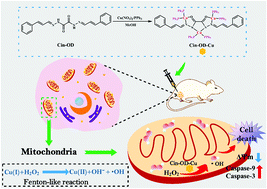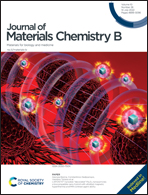A triphenylphosphine coordinated cinnamaldehyde-derived copper(i) Fenton-like agent with mitochondrial aggregation damage for chemodynamic therapy†
Abstract
Chemodynamic therapy (CDT), which uses agents to induce cell death by decomposing endogenous hydrogen peroxide (H2O2) into highly toxic hydroxyl radicals (˙OH), has been recognized as a promising approach to treat cancer. However, improving the efficiency of ˙OH production is considered one of the biggest challenges that limits the therapeutic efficacy of CDT. Herein, to controllably and efficiently induce oxidative damage through the production of ˙OH, we developed a new metal complex CDT agent with atomically precise structural characteristics as a deviation from traditional nanomaterial-CDT agents. The obtained CDT agent, a cinnamaldehyde derived copper(I) complex (denoted Cin-OD-Cu), was found to be continuously enriched in the mitochondria of A2780 ovarian carcinoma cells, which was accompanied by the generation of large amounts of ˙OH via Cu(I)-mediated Fenton-like reactions of H2O2, thereby stimulating oxidative stress in the mitochondria and eventually leading to cell death. Moreover, in vivo experiments showed that Cin-OD-Cu was capable of effectively inhibiting tumor growth with excellent biocompatibility. We believe this research enriches the limited selection of atomically precise metal complex CDT agents in particular for reactive oxygen species-mediated treatments aimed at inducing mitochondria oxidative damage; we anticipate that it will provide new insights into the development of novel, atomically precise agents for CDT.



 Please wait while we load your content...
Please wait while we load your content...